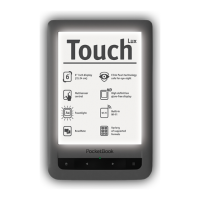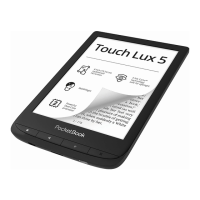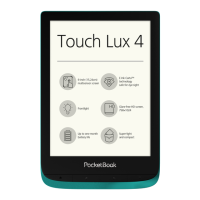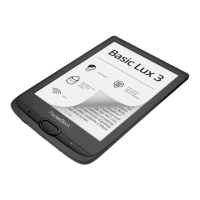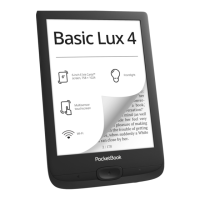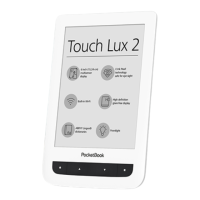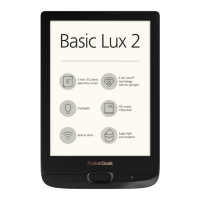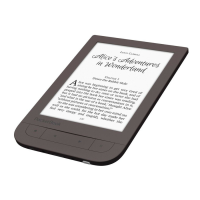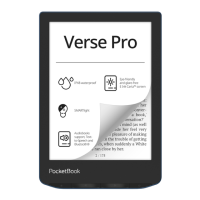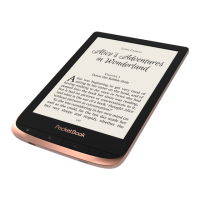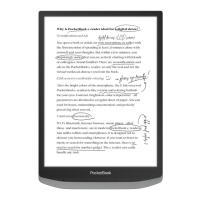Do you have a question about the Pocketbook Basic Lux and is the answer not in the manual?
Device care and upkeep guidelines, including handling, cleaning, and component integrity.
Information on radio frequency emissions and potential interference with medical devices.
Proper disposal and recycling instructions for the electronic device and its components.
Instructions for charging the device's battery for the first time and subsequent use.
Procedures for turning the device on/off, locking, unlocking, and restarting.
Visual guide to the device's main interface, including navigation and notification panels.
How to use device buttons for menu navigation, item selection, and page turning.
Guidance on using the virtual keyboard for text input and symbol selection.
Steps for connecting the device to a PC and transferring files.
Instructions for inserting and ejecting a microSD card for expanded storage.
Using Dropbox to sync files between the device and cloud storage.
Sending documents wirelessly to the device via email.
Managing the whitelist for receiving documents via email.
Managing the e-book collection, including filtering, sorting, and searching.
Options for organizing books by authors, genres, collections, and other categories.
Methods for ordering books by date, title, or author.
Different display modes for book lists, showing cover icons or detailed information.
Actions available for books, such as viewing info, marking, copying, or deleting.
How to navigate through book pages using device buttons.
Navigating cross-references, footnotes, and links within books.
Adjusting text size for different book formats for improved readability.
Accessing reader-specific functions like search, contents, and settings.
Directly navigating to a specific page number within a book.
Finding specific text within books that have a text layer.
Adding and managing bookmarks to easily return to specific pages.
Configuring reading preferences for EPUB, FB2, and other text-based formats.
Adjusting viewing settings specific to PDF and DjVu book formats.
Using the built-in dictionary for word translations and lookups.
Changing the screen orientation to suit reading preference or content.
Creating and managing notes within books.
Exiting the current book and returning to the library or previous menu.
Configuring network settings, connecting to available Wi-Fi networks.
Managing user accounts for services like Adobe DRM and PocketBook sync.
Authorizing the device for protected e-books and managing DRM documents.
Setting up email for receiving documents wirelessly to the device.
Linking and synchronizing the device with Dropbox cloud storage.
Customizing device appearance, startup behavior, and LED indicators.
Remapping hardware buttons to customize device controls.
Creating and managing profiles for different user settings and book statuses.
Selecting the device's interface language and keyboard layouts.
Adding and managing multiple keyboard languages for input.
Selecting which dictionaries are accessible for translation.
Setting the device's date, time, and time zone.
Optimizing battery usage through screen timeout and power-off settings.
Device maintenance tasks like USB mode setting and backup/recovery.
Protecting device settings with a password and managing usage data.
Checking firmware version and managing software updates.
Displaying device model, memory details, and software licenses.
Configuring the device to automatically check for and install firmware updates.
Step-by-step guide for manually updating the device's firmware via a computer.
| Technology | E Ink Carta |
|---|---|
| Display diagonal | 6 \ |
| Grayscale levels | 16 |
| Backlight display | Yes |
| Display resolution | 1024 x 758 pixels |
| Audio formats supported | Not supported |
| Image formats supported | BMP, JPG, PNG, TIF |
| Document formats supported | CHM, DOC, DOCX, DjVu, EPUB DRM, FB2, FB2.ZIP, HTM, HTML, MOBI, PDF, PRC, RTF, TCR, TXT |
| Processor frequency | 1000 MHz |
| RAM capacity | 256 MB |
| Compatible memory cards | MicroSD (TransFlash) |
| Maximum memory card size | 32 GB |
| Internal storage capacity | 8 GB |
| Wi-Fi standards | 802.11b, 802.11g, Wi-Fi 4 (802.11n) |
| USB connector type | Micro-USB |
| Rotating | - |
| Product color | Brown |
| Housing material | Glass, Plastic |
| Battery capacity | 1300 mAh |
| Battery life (max) | 730 h |
| Bundled software | Dropbox, Send-to-PocketBook, Library, Dictionaries, Gallery, Calculator, RSS News, Chess, Klondike, Snake, Sudoku |
| Depth | 8.3 mm |
|---|---|
| Width | 114.6 mm |
| Height | 174.4 mm |
| Weight | 170 g |
